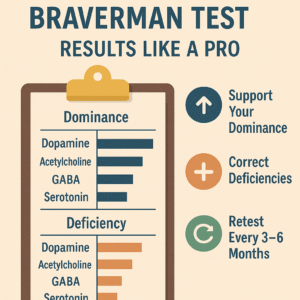Taking the Braverman Test is an insightful first step—but interpreting your results is what unlocks the real value. Here’s how to break down your scores and take informed action.
Understanding the Scores
The Braverman Test results include dominance and deficiency scores for four neurotransmitters: dopamine, acetylcholine, GABA, and serotonin. Your dominant score reveals your core brain style, while a deficiency score suggests what may be under-supported.
Example Profile:
- High dopamine = high energy, drive, reward sensitivity
- Low GABA = poor stress tolerance, sleep issues
The imbalance between these two may create mood swings, burnout, or anxiety.
How to Use the Results:
1. Support Your Dominance
Tailoring your lifestyle and habits to your dominant neurotransmitter can help you thrive while reducing the risk of overstimulation or burnout.
- High dopamine: Harness the drive and ambition by balancing stimulation with relaxation. Include GABA-rich foods (like oats, fermented dairy, and brown rice), and calming herbs such as lemon balm, passionflower, and magnesium glycinate.
- High acetylcholine: Stimulate learning and creativity with challenging mental tasks, but protect against burnout by scheduling regular breaks, engaging in mindfulness or meditation practices, and ensuring adequate choline intake from foods like eggs and soy lecithin.
- High GABA: Lean into your calm and structured nature, but be cautious of becoming too rigid or resistant to change. Gentle novelty, social engagement, and light stimulants like green tea can keep you balanced.
- High serotonin: Your emotional steadiness is a gift, but avoid complacency or emotional suppression. Physical activity, early sunlight exposure, and social connection help keep serotonin metabolism robust.
2. Correct Deficiencies
If one or more neurotransmitters score low, this may manifest as specific mental, emotional, or physical challenges.
- Low dopamine: Signs include low motivation, fatigue, and apathy. Support dopamine production with L-tyrosine, B-vitamins, protein-rich meals, and activities that bring reward and novelty.
- Low acetylcholine: May show up as forgetfulness, brain fog, or poor learning. Use citicoline or alpha-GPC supplements, phosphatidylserine, and foods like eggs and fish.
- Low GABA: Leads to overstimulation, anxiety, and sleep difficulties. Helpful interventions include magnesium, L-theanine, lemon balm, valerian root, and slow, rhythmic breathing.
- Low serotonin: Associated with low mood, irritability, and disrupted sleep. Increase tryptophan or 5-HTP intake, exercise regularly, and spend time in nature, particularly in early daylight.
3. Retest Every 3–6 Months
Neurotransmitter levels are dynamic and respond to lifestyle changes, diet, stress, and environment. Retesting periodically allows you to monitor progress and recalibrate your regimen.
Scientific Foundation:
- Braverman, E. (1997). The Edge Effect.
- Parnetti et al. (2007). Cholinergic precursors and memory Link
- Wurtman RJ. (1989). Neurochemical mood regulation Link
Final Thoughts
Rather than boxing you in, the Braverman Test offers a lens to understand your behavior, preferences, and challenges. Use it to create a personalized roadmap for brain balance, performance, and emotional resilience.
